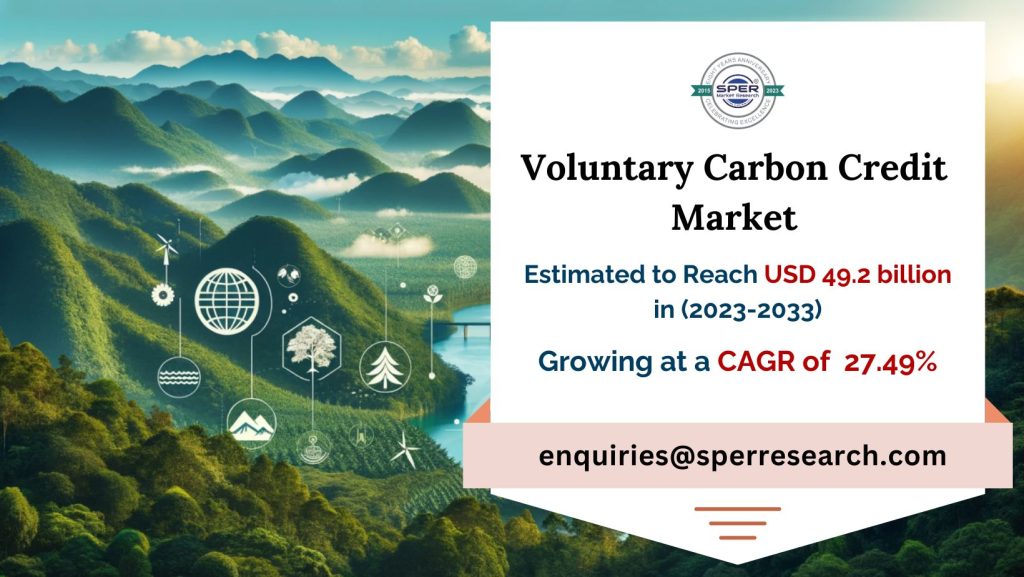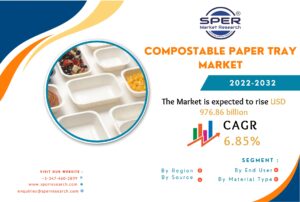In the Kyoto Protocol of 1997, the idea of carbon credits was first presented with the aim of lowering greenhouse gas (GHG) emissions into the atmosphere. Since then, other local legislation and international treaties have established corresponding measures in an effort to combat global warming. The 2015 Paris Agreement warrants special attention since it establishes carbon trading as a vital tool for cutting carbon emissions worldwide. The creation and trade of carbon certificates has been facilitated by international instruments such as the Paris Agreement and the Kyoto Protocol. Demand for carbon credits from organizations not required to engage in carbon markets has increased concurrently with the growth of compliance carbon markets.
According to SPER market research, ‘Voluntary Carbon Credit Market Size- By End User – Regional Outlook, Competitive Strategies and Segment Forecast to 2033’ state that the Voluntary Carbon Credit Market is predicted to reach 49.2 billion by 2033 with a CAGR of 27.49%.
Businesses are devoting a significant amount of time and resources to decarbonisation as the globe approaches net zero targets. Changes in the climate typically necessitate a total economic paradigm. The companies’ focus on net zero aims and efforts to reduce carbon emissions will drive a large increase in the demand for carbon credits in the upcoming decades. The right to emit greenhouse gasses equal to one ton of carbon dioxide is represented by a carbon credit. These days, a lot of companies are embracing this method of using carbon credits to partially offset their costs, which is really helping them. They are participating in initiatives and pursuits that assist them in producing offsets. They utilize as many credits as they need for a project, up to the cap, and any extra credits are applied to future projects.
Throughout the projection period, rising carbon credit prices could pose a market problem. A number of nations have made the commitment to become carbon neutral in order for humanity to maintain a liveable climate on Earth. Governments mostly use legislation, such as carbon taxes, or economic incentives to create carbon markets in order to reduce carbon emissions. While the economic slump has caused swings in the carbon market, energy considerations have had a long-term impact while economic causes have caused a short-term shock. The World Bank reports that the substantial increase in carbon prices over the past year is primarily attributable to the accelerating decarbonisation activities and increased demand.
Request For Free Sample Report @ https://www.sperresearch.com/report-store/voluntary-carbon-credit-market.aspx?sample=1
Impact of COVID-19 on Global Voluntary Carbon Credit Market
The COVID-19 pandemic presented both challenges and opportunity for the voluntary carbon credit industry. Disruptions on the supply side affected the production and verification of carbon credits, while changes in business goals and a heightened awareness of sustainability affected the dynamics on the demand side. The market’s long-term effects will depend on how consumers and businesses navigate the post-pandemic climate and if sustainability continues to be a primary emphasis in recovery efforts.
Voluntary Carbon Credit Market Key Players:
Due to the region’s growing participation in sustainability and climate mitigation initiatives, North America has the largest revenue share geographically. A rise in renewable energy expenditures, particularly in solar and wind projects, is driving up demand for carbon credits derived from renewable energy sources. Planting and replanting initiatives are growing in popularity as countries emphasize the need to stop deforestation and restore ecosystems in order to satisfy international objectives for forest restoration and produce carbon credits. Other prominent companies that lead the market are 3Degrees, ALLCOT, Atmosfair, CarbonClear, Climate Impact Partners, ClimeCo LLC., EcoAct, and Ecosecurities.
Our in-depth analysis of the Voluntary Carbon Credit Market includes the following segments:
By End User:
-
Agriculture
-
Carbon Capture & Storage
-
Chemical Process
-
Forestry and Land Use
-
Household and Community
-
Industrial and Commercial
-
Renewable Energy
-
Transportation
-
Waste Management
By Region:
-
Asia-Pacific
-
Europe
-
Middle East & Africa
-
North America
-
Latin America
For More Information, refer to below link:-
Voluntary Carbon Credit Market Outlook
Related Reports:
Follow Us –
LinkedIn | Instagram | Facebook | Twitter
Contact Us:
Sara Lopes, Business Consultant – USA
SPER Market Research
+1–347–460–2899



